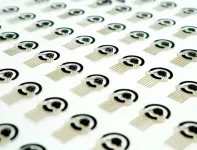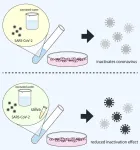(Press-News.org) Our brain is remarkably flexible in producing different reactions to supposedly comparable situations. The same sensory information can lead to different decisions depending on the behavioral context. One example of this is a penalty kick in soccer: a player can either choose the empty corner of the goal as the target or aim directly at the goalkeeper in the hope that he will jump aside. Both decisions are based on the same perception of the goalkeeper's position, but lead to completely different actions. Neuroscientists at the German Primate Center (DPZ) - Leibniz Institute for Primate Research in Göttingen have investigated how the brain implements this type of flexibility. Their results show that, depending on the requirements, our brain either reuses known neural pathways or develops new patterns to select movements depending on the context. Thus, goal-directed behavior and cognitive flexibility can be achieved in different ways, depending on the circumstance that made the flexible adaptation of behavior necessary. The findings help to understand why it is more difficult to adapt to some new situations than to others - whether in social interactions or motor tasks (Nature Communications).
The researchers trained rhesus monkeys to plan arm movements and recorded the activity of neurons in the brain that are involved in planning these movements. The monkeys performed the task in two different contexts. In the first context, they had to use a learned rule to decide whether they should point at the target displayed on the screen (“goalkeeper”) or choose the opposite side of the screen (“empty corner”). In the second context, the monkeys had to adapt to an altered sensory environment by performing the tasks under mirror-inverted viewing conditions. Here, too, a target shown on one side was linked to a movement to the opposite side.
The study showed that the brain works in different ways in the two situations. In the first context, which is based on learned rules, the brain drew on existing neural patterns. It used the pre-existing networks to plan the movement without making fundamental changes to the neural connections. In the second context, where the sensory environment had changed, the brain had to develop new neural patterns to accomplish the task. The flexibility of the brain to interpret and respond to the same sensory information differently depending on the situation is therefore achieved in different ways.
“Flexibly associating different behaviors with a given situation is a core competence of our brain,” explains Alexander Gail, head of the Sensorimotor Research Group and the study. “Sometimes this requires a complex restructuring of neuronal circuits, but often so-called cognitive control is sufficient, in which - as our new findings suggest - neuronal patterns already known to the brain are reused. We assume that this mechanism also comes into play when we make decisions in changing social contexts, which may be more competitive or more collaborative, for example - but we have yet to prove this.”
END
Keeper or corner?
Neuroscientists show how the brain enables flexible decisions
2025-02-03
ELSE PRESS RELEASES FROM THIS DATE:
Printable molecule-selective nanoparticles enable mass production of wearable biosensors
2025-02-03
The future of medicine may very well lie in the personalization of health care—knowing exactly what an individual needs and then delivering just the right mix of nutrients, metabolites, and medications, if necessary, to stabilize and improve their condition. To make this possible, physicians first need a way to continuously measure and monitor certain biomarkers of health.
To that end, a team of Caltech engineers has developed a technique for inkjet printing arrays of special nanoparticles that enables the mass production of long-lasting wearable sweat sensors. These sensors could be used to monitor a variety of biomarkers, ...
Mapping the yerba mate genome reveals surprising facts about the evolution of caffeine
2025-02-03
Yerba mate, along with tea and coffee, is one of the world’s most popular caffeinated beverages. Widely consumed in South America, this remarkable plant is rich in diverse, bioactive compounds that contribute many health benefits.
An international group of researchers has mapped the yerba mate genome, providing insights into the biosynthesis of caffeine in yerba mate. This new information provides opportunities for creating plant varieties with new characteristics.
The work, led by the ...
Electricity prices across Europe to stabilise if 2030 targets for renewable energy are met, study suggests
2025-02-03
Hitting the current national 2030 quotas for solar and wind energy could reduce the volatility of electricity markets by an average of 20% across 29 European countries, according to a new study from the University of Cambridge.
The intensity of spikes in power prices are predicted to fall in every country by the end of the decade if commitments to green energy are met, as natural gas dependency is cut.
The UK and Ireland would be the biggest beneficiaries, with 44% and 43% reductions in the severity of electricity price spikes by 2030, compared with last year.
Germany could experience a 31% decline in electricity price ...
Improved treatment timing reduces honey bee losses to Varroa mites
2025-02-03
Honey bee mortality can be significantly reduced by ensuring that treatments for the parasitic Varroa mite occur within specific timeframes, a new study reveals.
The mites—belonging to the species Varroa destructor—feed on the larvae of bees and can destroy colonies if not treated at key points to reduce or remove infestations.
But researchers have found that more than a third of beekeepers surveyed in England and Wales deviate from recommended treatment guidelines, including application windows.
Crucially, they found that beekeepers who mistimed Varroa mite treatments experienced exacerbated colony losses, with the effect occurring ...
CAR-T cells can arm bystander T cells with CAR molecules via trogocytosis
2025-02-03
Engineered immune cells called CAR-T cells are used in the treatment of cancer. Researchers from Uppsala University have now discovered that CAR molecules can be transferred from the CAR-T cells to other T cells in the tumour microenvironment. The researchers also pinpoint how this transfer is regulated, which may be used to improve the efficacy of CAR-T cell therapy. The study has been published in the journal Science Immunology.
Immune cells have a capacity to exchange cell surface molecules between one another. This exchange is called trogocytosis and may potentially impact the immune response since it allows different proteins to be transferred between cells.
Chimeric antigen ...
Can ocean-floor mining oversights help us regulate space debris and mining on the Moon?
2025-02-03
by Nishith Mishra, Martina Elia Vitoloni, and Dr Joseph Pelton
Mining ocean resources needed for electric cars and other devices is currently a hot issue of dispute. Final resolution of how or whether the seabed should be expl18oited is pending. Outcomes in this contentious area could create precedents that could impact decisions about mining the moon.
These precedents might shape the how and why of mining the Moon and shape the future and the sustainability of space activities of human beings. But this is only one possible precedent that could reshape the future of space.
Pending international discussions on space traffic management, space debris removal, and limiting ...
Observing ozonated water’s effectiveness against SARS-CoV-2 in saliva
2025-02-03
Disinfecting surfaces is crucial in keeping bacteria and viruses at bay, but the cleaning solutions could be ineffective if met with neutralizing compounds.
Ozonated water has a strong disinfection effect on mold and bacteria, and is also shown to work on SARS-CoV-2, which is responsible for COVID-19. The downside is that ozonated water breaks down quickly in the presence of organic matter, which reduces its effectiveness. SARS-CoV-2 is transmitted through droplets mixed with bodily fluids, such as saliva and nasal mucus which contain organic matters. For this reason, it is necessary to investigate how effective ozonated water is in the presence of ...
Alcohol-related deaths up 18% during pandemic
2025-02-03
Alcohol-related deaths increased 18% during the pandemic, as did hospitalizations related to alcohol use, according to new research in CMAJ (Canadian Medical Association Journal) https://www.cmaj.ca/lookup/doi/10.1503/cmaj.241146.
In the early part of the pandemic, retail alcohol sales volume in Canada increased by 2% (2020/21 v. 2019), the highest increase in 10 years, despite few international visitors. More than 1 in 4 people (26%) reported drinking more, and 18% reported heavy drinking (defined as ...
Mothers of twins face a higher risk of heart disease in the year after birth
2025-02-03
The risk of being admitted to the hospital with heart disease is twice as high the year after birth for mothers of twins compared to singleton births, according to research published in the European Heart Journal [1] today (Monday). The risk is even higher in mothers of twins who had a high blood pressure condition during pregnancy.
The research was led by Professor Cande Ananth from the Department of obstetrics, gynecology, and reproductive sciences at Rutgers Robert Wood Johnson Medical School, New Jersey, USA.
He said: “The rate of twin pregnancies worldwide ...
A new approach to detecting Alzheimer’s disease
2025-02-03
Research led by Lancaster University has revealed clear evidence that changes in the orchestration of brain oxygenation dynamics and neuronal function in Alzheimer’s disease contribute to the neurodegeneration.
The study “Neurovascular phase coherence is altered in Alzheimer’s Disease” is published in Brain Communications. The lead author is Aneta Stefanovska with Juliane Bjerkan, Gemma Lancaster, Peter McClintock and Trevor Crawford from Lancaster University and Bernard Meglič and Jan Kobal from the University of Ljubljana Medical Centre in Slovenia.
Professor Stefanovska said: “Alzheimer's can be hypothesised as being a result ...
LAST 30 PRESS RELEASES:
Manganese gets its moment as a potential fuel cell catalyst
“Gifted word learner” dogs can pick up new words by overhearing their owners’ talk
More data, more sharing can help avoid misinterpreting “smoking gun” signals in topological physics
An illegal fentanyl supply shock may have contributed to a dramatic decline in deaths
Some dogs can learn new words by eavesdropping on their owners
Scientists trace facial gestures back to their source. before a smile appears, the brain has already decided
Is “Smoking Gun” evidence enough to prove scientific discovery?
Scientists find microbes enhance the benefits of trees by removing greenhouse gases
KAIST-Yonsei team identifies origin cells for malignant brain tumor common in young adults
Team discovers unexpected oscillation states in magnetic vortices
How the brain creates facial expressions
Researchers observe gas outflow driven by a jet from an active galactic nucleus
Pitt student finds familiar structure just 2 billion years after the Big Bang
Evidence of cross-regional marine plastic pollution in green sea turtles
Patients with clonal hematopoiesis have increased heart disease risk following cancer treatment
Stem cell therapy for stroke shows how cells find their way in the brain
Environment: Up to 4,700 tonnes of litter flows down the Rhine each year
Maternal vaccine receipt and infant hospital and emergency visits for influenza and pertussis
Interim safety of RSVpreF vaccination during pregnancy
Stem cell engineering breakthrough paves way for next-generation living drugs
California grants $7.4 million to advance gene-edited stem cell therapy for Friedreich’s ataxia
Victoria’s Secret grant backs cutting-edge ovarian cancer research
Research paves the way for safer colonoscopy bowel prep for people with compromised gut health
JMIR Publications and Sweden's National Library announce renewal and expansion of flat-fee unlimited open access partnership for 2026
A new 3D-printed solar cell that’s transparent and color-tunable
IV iron is the cost-effective treatment for women with iron deficiency anemia and heavy menstrual bleeding
Doing good pays off: Environmentally and socially responsible companies drive value and market efficiency
City of Hope and Cellares to automate manufacturing of solid tumor CAR T cell therapy
Short-circuiting pancreatic cancer
Groundbreaking mapping: how many ghost particles all the Milky Way’s stars send towards Earth
[Press-News.org] Keeper or corner?Neuroscientists show how the brain enables flexible decisions







